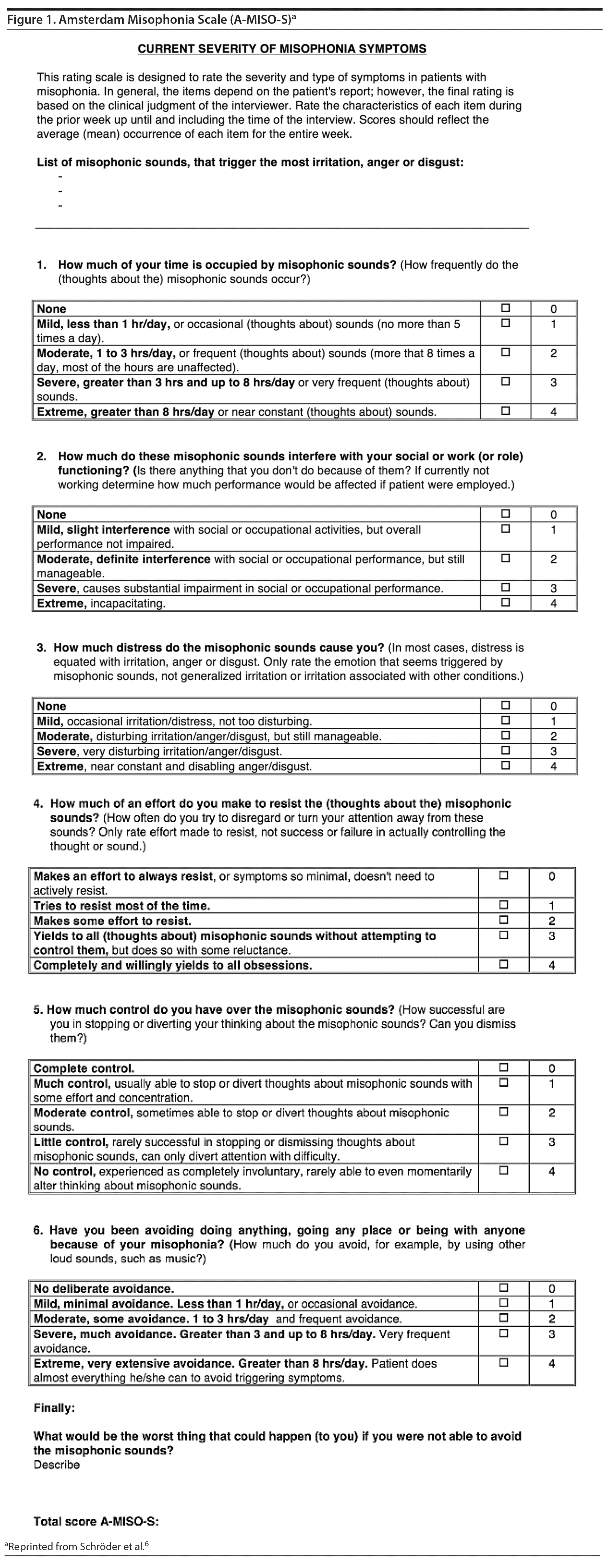
A Case of Bipolar Disorder and Misophonia
Misophonia refers to a condition in which repetitive, pattern-based sounds such as chewing or pen clicking act as triggers, leading to abnormally strong aversive emotional responses and behavioral reactions.1,2 Misophonia has been linked to obsessive-compulsive disorder,3 tic disorders,4 posttraumatic stress disorder, and suicidality.5 However, there are no reports of misophonia in patients with bipolar disorder. We describe a case of chronic and severe misophonia in a patient with bipolar II disorder.
Case Report
Ms A is a 43-year-old single mother who has been seen in our clinic for 16 years. She was initially referred during her only pregnancy for follow-up care for bipolar II disorder. Her past psychiatric history was notable for obsessive-compulsive disorder and panic disorder.
She attends our clinic every 2-4 months. With the exception of occasional brief episodes of mild depression, her mood has been fairly stable for several years. She has not required a psychiatric hospitalization, has not had any suicide attempts, and has been functioning at a good level. She has not had a recurrence of obsessive-compulsive disorder or panic disorder. Her current medications include lithium 600 mg, quetiapine 125 mg, temazepam 30 mg, and carbamazepine 800 mg/day. She also takes primidone 250 mg/day for hand tremor. There is no history of alcohol abuse or use of illicit drugs.
Following an informal inquiry into the prevalence of misophonia in patients with bipolar disorder seen at our clinic, Ms A endorsed a history of these symptoms since childhood. The symptoms grew progressively worse and peaked when she was 19 years old. She recalled being unable to sleep on family trips due to the sound of her parents’ snoring and breathing. She found herself becoming increasingly intolerant of crunching and chewing sounds. Other triggers included coughing, choking, clicking of a computer mouse, rubbing of fingers, and cracking of knuckles. In response to these sounds, she would often get irritated and express aggression toward inanimate objects. As an adult, the misophonia significantly impacted her quality of life, as she was unable to share a room with her child, eat with her family, or retain a job. Her family history was positive for major depressive disorder and bipolar disorder. She was unaware of any family history of misophonia.
On the Amsterdam Misophonia Scale,6 a 6-item scale (score range, 0-24) adapted from the Yale-Brown Obsessive-Compulsive Scale,7 she scored 17, indicating severe misophonia. Figure 1 provides details of the Amsterdam Misophonia Scale. There was no correlation between misophonia and symptoms of obsessive-compulsive disorder in the past. Similarly, there was no change in the intensity or frequency of misophonia during euthymic intervals; however, there was a clear worsening of these symptoms during the depressive episodes with mixed features.
Discussion
Misophonia appears to be a common entity. A study8 of 483 undergraduate students at the University of South Florida showed that 19.9% of participants experienced misophonia symptoms that significantly interfered with their lives. A replication of this study found that 6% of individuals experienced misophonia, leading to severe functional impairment.9 Further, a large-scale study5 of 300 patients with misophonia showed that 45% of their symptoms started in childhood, and 75% of patients stated that symptoms worsened over time. The presence of misophonia in the pediatric population has been investigated, with an emphasis on the potential for early intervention.10 However, the current literature on treatment of misophonia is limited. A few case reports11,12 have shown cognitive-behavioral therapy (CBT) to be effective in reducing symptom severity. A study10 of 90 misophonic patients reported that CBT improved misophonic symptoms in 48% of patients. Although promising, these studies are limited by sample size and lack of follow-up and a control group. Nevertheless, the significant impairment experienced by misophonic patients warrants further research into potential interventions and treatments.
There is little consensus on the nosologic status of misophonia. It has been suggested that misophonia may be an independent psychiatric disorder with a distinct diagnostic criteria and psychopathology,6 while an alternative hypothesis suggests that misophonia is a cluster of symptoms that manifests across a variety of psychiatric disorders.13 Based on a study6 of 42 Dutch self-referred misophonic patients, it was found that patients with misophonia showed common predictable triggers and strong patterns of avoidant behavior that resulted in significant social dysfunction. Although misophonia shares features with specific phobias, obsessive-compulsive disorder, posttraumatic stress disorder, and autism spectrum disorders, the pattern of symptoms found in misophonia did not fit into the diagnostic criteria of any of these disorders, suggesting that misophonia should be considered a separate diagnosis.
In 1 study,5 patients with no comorbid psychiatric disorders showed less severe misophonic complaints, suggesting that the progression and severity of misophonia may positively correlate with comorbid psychiatric conditions. Our patient continued to struggle with symptoms of misophonia in spite of having prolonged euthymic intervals. These symptoms were severe enough to interfere with her relationships and quality of life.
Although there are no neurophysiologic studies of misophonia in the context of bipolar disorder, dysfunction of the auditory processing system has been described in both disorders.14,15 Furthermore, research16 showing impaired auditory gating in bipolar disorder has suggested that patients with bipolar disorder are already hypersensitive to auditory stimuli, predisposing them to sound intolerance. The common occurrence of psychiatric disorders in individuals with misophonia, although not conclusive evidence for its nosologic classification per se, may indicate shared underlying pathophysiology among misophonia and these disorders. Although the interactions between bipolar disorder and misophonia remain unclear, we suggest that there may be some value in screening for misophonic symptoms during episodes of bipolar depression with mixed features.
Published online: April 30, 2020.
Potential conflicts of interest: Dr Sharma has received grant support from, participated on scientific advisory boards for, or served on speakers’ bureaus of Assurex, Genome Canada, Neurocrine Biosciences, Otsuka, Sage Therapeutics, Stanley Medical Research Institute, and Sunovion and reports personal fees from Neuroscience Education Institute. Ms Sharan reports no conflicts of interest related to the subject of this report.
Funding/support: None.
Patient consent: The patient reviewed the report and provided written consent for publication, and information has been de-identified to protect anonymity.
REFERENCES
1.Jastreboff PJ, Jastreboff MM. Treatments for decreased sound tolerance (hyperacusis and misophonia). Semin Hear. 2014;35(2):105-120. CrossRef
2.Brout JJ, Edelstein M, Erfanian M, et al. Investigating misophonia: a review of the empirical literature, clinical implications, and a research agenda. Front Neurosci. 2018;12:36. PubMed CrossRef
3.Webber TA, Johnson PL, Storch EA. Pediatric misophonia with comorbid obsessive-compulsive spectrum disorders. Gen Hosp Psychiatry. 2014;36(2):231.e1-231.e2. PubMed CrossRef
4.Robinson S, Hedderly T, Conte G, et al. Misophonia in children with tic disorders: a case series. J Dev Behav Pediatr. 2018;39(6):516-522. PubMed CrossRef
5.Rouw R, Erfanian M. A large-scale study of misophonia. J Clin Psychol. 2018;74(3):453-479. PubMed CrossRef
6.Schröder A, Vulink N, Denys D. Misophonia: diagnostic criteria for a new psychiatric disorder. PLoS One. 2013;8(1):e54706. PubMed CrossRef
7.Goodman WK, Price LH, Rasmussen SA, et al. The Yale-Brown Obsessive Compulsive Scale, I: development, use, and reliability. Arch Gen Psychiatry. 1989;46(11):1006-1011. PubMed CrossRef
8.Wu MS, Lewin AB, Murphy TK, et al. Misophonia: incidence, phenomenology, and clinical correlates in an undergraduate student sample. J Clin Psychol. 2014;70(10):994-1007. PubMed CrossRef
9.Zhou X, Wu MS, Storch EA. Misophonia symptoms among Chinese university students: incidence, associated impairment, and clinical correlates. J Obsessive Compuls Relat Disord. 2017;14:7-12. CrossRef
10.Schröder AE, Vulink NC, van Loon AJ, et al. Cognitive-behavioral therapy is effective in misophonia: an open trial. J Affect Disord. 2017;217:289-294. PubMed CrossRef
11.McGuire JF, Wu MS, Storch EA. Cognitive-behavioral therapy for 2 youths with misophonia. J Clin Psychiatry. 2015;76(5):573-574. PubMed CrossRef
12.Bernstein RE, Angell KL, Dehle CM. A brief course of cognitive behavioral therapy for the treatment of misophonia: a case example. Cogn Behav Ther. 2013;6:e10. CrossRef
13.Cavanna AE, Seri S. Misophonia: current perspectives. Neuropsychiatr Dis Treat. 2015;11:2117-2123. PubMed CrossRef
14.Schröder A, van Diepen R, Mazaheri A, et al. Diminished n1 auditory evoked potentials to oddball stimuli in misophonia patients. Front Behav Neurosci. 2014;8:123. PubMed
15.Lijffijt M, Moeller FG, Boutros NN, et al. Diminished P50, N100 and P200 auditory sensory gating in bipolar I disorder. Psychiatry Res. 2009;167(3):191-201. PubMed CrossRef
16.Cabranes JA, Anc×n I, Santos JL, et al. P50 sensory gating is a trait marker of the bipolar spectrum. Eur Neuropsychopharmacol. 2013;23(7):721-727. PubMed CrossRef
aSchulich School of Medicine and Dentistry, London, Ontario, Canada
bDepartment of Psychiatry, University of Western Ontario, London, Ontario, Canada
*Corresponding author: Verinder Sharma, MBBS, FRCP(C), Department of Psychiatry, University of Western Ontario, c/o Parkwood Institute, Mental Health Care Bldg, 550 Wellington Rd, London, Ontario N6C 0A7 Canada ([email protected]).
Prim Care Companion CNS Disord 2020;22(3):19l02523
To cite: Sharan R, Sharma V. A case of bipolar disorder and misophonia. Prim Care Companion CNS Disord. 2020;22(3):19l02523.
To share: https://doi.org/10.4088/PCC.19l02523
© Copyright 2020 Physicians Postgraduate Press, Inc.
Please sign in or purchase this PDF for $40.00.






